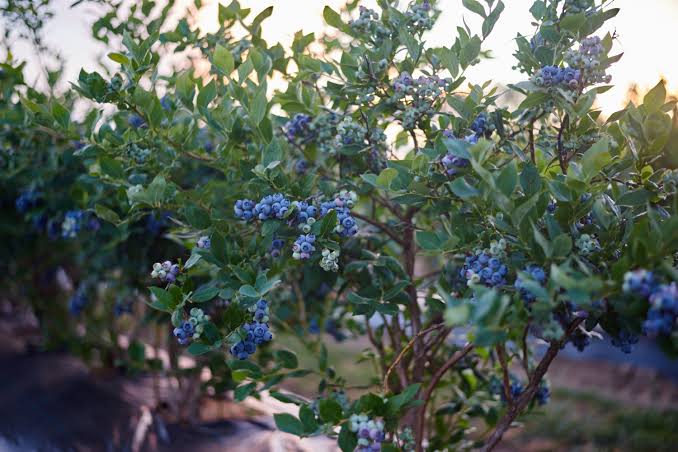Growing blueberries is a delightful and rewarding endeavor for anyone who loves fresh, sweet berries. To start, choose a sunny spot in your garden with well-draining soil. Blueberries thrive in acidic soil, so it’s a good idea to test and adjust the pH if needed.
Once you’ve prepared the soil, select blueberry plants suitable for your region. There are different varieties, each with its unique flavor and size. Planting in the early spring or fall is ideal, ensuring the roots establish themselves before the growing season.
Watering is crucial for young blueberry plants, so keep the soil consistently moist but not waterlogged. Mulching around the base helps retain moisture and prevents weeds. Blueberries appreciate a layer of organic mulch, like pine straw or wood chips.
As your blueberry bushes mature, proper pruning is essential for optimal fruit production. Trim away dead or crowded branches in late winter or early spring. This encourages new growth and ensures better air circulation, preventing diseases.
Blueberries are relatively low-maintenance, but regular fertilization is beneficial. Use a balanced fertilizer in the spring, and if your soil lacks acidity, consider adding an acidifying fertilizer to maintain the preferred pH level.
Come summer, the excitement begins as the blueberries ripen. Harvesting is easy – simply pluck the ripe berries by hand. The best part is enjoying the fresh, juicy fruit straight from the bush. Blueberries are not only delicious but also packed with antioxidants and vitamins, making them a healthy addition to your diet.
Beyond the joy of growing and harvesting, blueberries are versatile in the kitchen. From classic blueberry muffins to refreshing salads, there are countless recipes to explore. Whether eaten fresh, frozen, or incorporated into various dishes, blueberries offer a burst of flavor and nutritional goodness.
However, growing blueberries is a fulfilling journey that connects you to nature and provides a bountiful harvest of tasty, nutritious berries. With proper care and attention, your blueberry bushes can thrive for years, offering a continuous supply of these delightful gems for you and your loved ones to enjoy.
Read Also: Angelonia Flowers – All you need to know
What is the Best way to Grow Blueberries?

The best way to grow blueberries is to start by selecting a sunny location with well-draining, acidic soil. Conduct a soil test to ensure the pH is between 4.5 and 5.5, as blueberries thrive in acidic conditions. Amend the soil with organic matter if necessary.
Choose the right blueberry varieties for your climate and region. Plant them in early spring or fall, allowing the roots to establish before the growing season. Provide regular, consistent watering, keeping the soil moist but not waterlogged. Mulch around the base to retain moisture and suppress weeds.
Prune the blueberry bushes annually, removing dead or crowded branches to promote airflow and new growth. Fertilize with a balanced fertilizer in the spring, and if your soil lacks acidity, use an acidifying fertilizer.
Harvest ripe berries by hand during the summer. Enjoy the fresh fruit or explore various recipes to make the most of your blueberry harvest. With proper care and attention to soil conditions, water, pruning, and fertilization, you can cultivate healthy and fruitful blueberry bushes in your garden.
Additionally, it’s essential to monitor the health of your blueberry plants and be proactive in pest management. Keep an eye out for common pests like aphids, mites, or fruit worms. If needed, employ natural or organic pest control methods to protect your blueberries without harmful chemicals.
Consider planting different varieties of blueberries to ensure a more extended harvest season and better cross-pollination. Blueberries are generally self-pollinating, but having multiple bushes can enhance fruit production.
Throughout the growing season, be mindful of any signs of nutrient deficiencies, such as yellowing leaves. Adjust your fertilization routine accordingly, providing the necessary nutrients to support robust growth.
As your blueberry bushes mature, you may find that they become more productive with each passing year. Patience is key, and with proper care, your blueberry plants can continue to bear delicious fruit for many seasons.
Remember that blueberries are not only a delightful addition to your garden but also a beneficial companion to other plants. Their shallow roots make them suitable for interplanting with acid-loving companions like azaleas, rhododendrons, or ferns.
Growing successful blueberries involves a holistic approach, considering factors like soil quality, watering, pruning, fertilization, pest management, and companion planting. By nurturing your blueberry bushes with care and attention, you can enjoy a bountiful harvest of these delectable berries year after year.
Read Also: Artemisia Flowers – All you need to know
What are the Best way to Care for Blueberries

Caring for blueberries involves several key practices to ensure healthy plants and a bountiful harvest. Here are the best ways to care for blueberries:
1. Sun and Soil:
Location: Plant blueberries in a sunny spot with at least six hours of sunlight daily.
Soil pH: Blueberries prefer acidic soil with a pH between 4.5 and 5.5. Test and adjust the soil as needed.
2. Planting:
Variety Selection: Choose blueberry varieties suited to your climate and region.
Planting Time: Plant in early spring or fall to allow roots to establish before the growing season.
3. Watering:
Consistent Moisture: Keep the soil consistently moist but not waterlogged, especially during dry spells.
Mulching: Apply a layer of organic mulch around the base to retain moisture and suppress weeds.
4. Pruning:
Annual Pruning: Prune in late winter or early spring to remove dead or crowded branches, promoting airflow and new growth.
5. Fertilization:
Balanced Fertilizer: Use a balanced fertilizer in spring, and consider an acidifying fertilizer if soil lacks acidity.
Timing: Fertilize early in the growing season and avoid excessive nitrogen, which can harm fruit production.
6. Pest Management:
Regular Monitoring: Keep an eye out for pests like aphids and mites. Employ natural or organic pest control methods if needed.
7. Harvesting:
Ripe Fruit: Harvest ripe berries by hand during the summer. Be gentle to avoid damaging the delicate fruit.
Frequency: Harvest regularly to encourage continued fruit production.
8. Companion Planting:
Beneficial Companions: Consider planting blueberries alongside acid-loving companions like azaleas or rhododendrons.
9. Nutrient Management:
Leaf Health: Monitor leaves for signs of nutrient deficiencies. Adjust fertilization to provide necessary nutrients.
10. Patience:
Maturation: Blueberry bushes may become more productive with age. Be patient and continue providing proper care.
Incorporating these practices into your blueberry care routine, you can create an environment that encourages healthy growth and ensures a consistent supply of delicious, homegrown berries.
How long Does it take Blueberries to Grow?

The time it takes for blueberries to grow and produce fruit depends on several factors, including the age of the plant when you start, the variety of blueberry, and local growing conditions.
Generally, blueberry plants can start producing a small amount of fruit within two to three years after planting. However, it’s common for the best yields to occur when the plants are around six years old and older.
The initial years are crucial for establishing a strong root system and healthy growth. Proper care, including soil preparation, pruning, and adequate watering, can contribute to the overall health and earlier fruiting of the blueberry bushes.
While you might see some fruiting within a couple of years, it takes several years for blueberry plants to reach full maturity and optimum fruit production.
As your blueberry bushes mature, you can expect an increase in fruit production. The growth rate can vary between different blueberry varieties, with some becoming more productive earlier than others. Patience is key in the early years, as the plants focus on developing strong roots and branches.
Continued care, such as regular pruning to encourage new growth and proper fertilization to provide essential nutrients, plays a vital role in the overall productivity of blueberry plants. Ensuring they receive adequate sunlight, maintaining optimal soil acidity, and addressing any pest or disease issues promptly will contribute to the health and longevity of your blueberry bushes.
It’s worth noting that the first few years of growth are an investment in the long-term success of your blueberry harvest. Once established, healthy blueberry plants can bear fruit for many years, providing you with a steady supply of delicious berries to enjoy. Remember to celebrate the milestones along the way, from the first tiny berries to the bountiful harvests as your blueberry bushes mature.
Read Also: Complete Steps in Paper Recycling Guide






